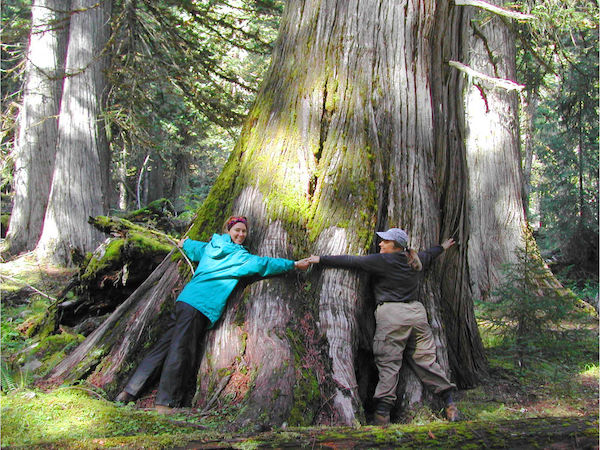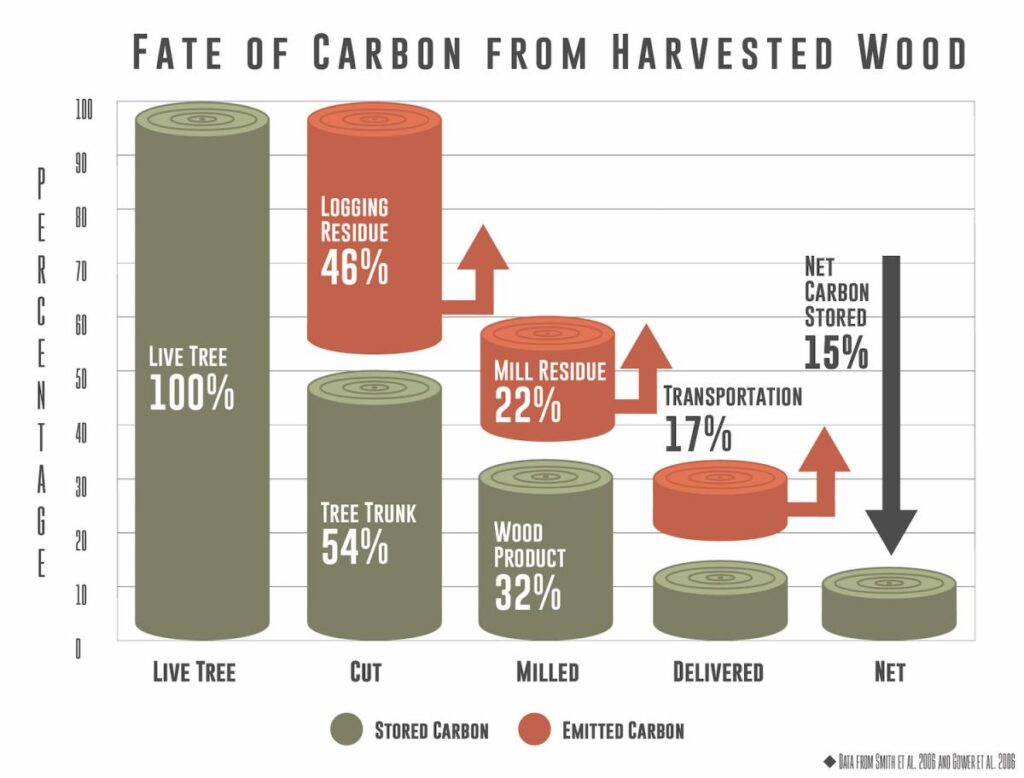
In recent decades scientists have examined the essential role forests play in mitigating the effects of climate change, expanding their value beyond the long-recognized aesthetic and ecological ones. Continue reading to learn how your support for Friends of the Clearwater makes a difference globally.
Billions of years ago biological processes such as photosynthesis began removing carbon dioxide (CO2) from the earth’s atmosphere, storing dead trees and other organic remains in places inaccessible to oxygen, such as swamps. Time and geological forces combined to convert this matter into carbon rich substances such as coal and oil, and store them underground. Over eons of time, this carbon sequestration decreased atmospheric CO2 enough to moderate its greenhouse effect, cooling earth’s climate substantially and allowing complex ecosystems to evolve.
These are among the scientific facts cited by proponents of the “Gaia Principle”—an evolutionary theory highlighting the interactions of Earth’s living organisms with their surroundings to form a synergistic and self-regulating complex system that maintains and perpetuates the biosphere as we know it. The term “Gaia” is taken from Greek mythology—the name of the primordial goddess who personifies the Earth—the mother of all life.
Nowadays, forests, grasslands, shrublands and other native ecotones are a living manifestation of the balance achieved by Gaia’s evolutionary processes. Solar driven photosynthesis continues to remove CO2 from the air, accumulating complex carbon substances in living tissues, soil organisms and detritus, carcasses, and wood above and below ground, alive and dead.
Enter the Anthropocene: the recently recognized geological era marked by the significant impacts of human activities on the Earth’s biosphere. Combustion of fossil fuels over the last 150 years or so has reintroduced large quantities of the stored carbon back to the atmosphere as CO2. Land use and other industrial activities emit other anthropogenic greenhouse gases such as methane—an even more potent greenhouse gas. This disruption of Gaia’s delicate carbon balance has trended the earth’s average annual atmospheric temperature upward, causing what’s popularly known as “global warming” or—recognizing that global effects are more complex than simply a rise in temperature—“climate change” or even “climate chaos.”
Scientists calculate that worldwide, forests remove huge quantities of CO2 from the atmosphere—nearly one-third of all the fossil fuel emissions annually—storing carbon in trees and soils. Here in the U.S., forests annually take up from the atmosphere roughly 12% of this nation’s disproportionately high greenhouse gas emissions.
"Forests remove nearly one-third of all the fossil fuel emissions annually—storing carbon in trees and soils."
One study documented that large trees play a major role in the accumulated carbon stock in some Pacific Northwest forests. Another study of national forests from the west coast states to the Appalachian Mountains concludes, as trees age they absorb and store more carbon than smaller trees, and as the entire forest matures it collectively accumulates massive amounts of carbon in vegetation and soil. Intact mature and old forests are vitally important as nature-based climate solutions.
Natural disturbances such as fire, weather and processes of decay cycle some carbon back into the air as CO2. Even so, scientists discovered that the vast majority of carbon stored in trees before two large wildfires in California’s Sierra Nevada mountain range remained there after the fires. This continuous cycle sustained a livable climate and a net zero carbon balancing act prior to the onset of the Anthropocene.
Two-thirds of a tree's carbon is lost during harvest.
Now, as undeveloped “primary” forests are degraded by management that features tree removal and other manipulations of the structure of forest vegetation, their overall carbon stocks are reduced along various pathway of greenhouse gases emission, which worsens the trajectory of climate change. One scientific analysis, as illustrated below, estimates one-third of the carbon in trees logged or otherwise removed from forests ends up in wood products such as lumber, with the remainder emitted to the atmosphere almost immediately, much of it burned for dirty energy in biomass facilities or as fuel at lumber mills (e.g., branches, tree tops, bark, round parts, mill residues). Factoring in carbon emissions from transportation further reduces the net carbon storage of wood utilization to only about 15%. And this doesn’t even consider later emissions depending upon the eventual fate of the wood products. In terms of climate benefits, there is a stark difference in climate impacts between forest conservation and human consumption and management.

As long as earth’s primary forests continue to be exploited for wood products, burned as part of false fire risk “fuel reduction” solutions, or “thinned” and “treated” to “increase forest resilience” (most of this terminology being agency or industry greenwashing), net carbon storage will remain below Gaia’s natural provision.
The Intergovernmental Panel on Climate Change (IPCC) is the United Nations body established in 1988 to provide periodic scientific assessments about climate change. IPCC’s 2023 Climate Change Synthesis Report Summary for Policymakers foresee some consequences of ongoing climate change:
Human activities, principally through emissions of greenhouse gases, have unequivocally caused global warming, with global surface temperature reaching 1.1°C above 1850-1900 in 2011-2020. Global greenhouse gas emissions have continued to increase, with unequal historical and ongoing contributions arising from unsustainable energy use, land use and land-use change, lifestyles and patterns of consumption and production across regions, between and within countries, and among individuals.
Widespread and rapid changes in the atmosphere, ocean, cryosphere and biosphere have occurred. Human-caused climate change is already affecting many weather and climate extremes in every region across the globe. This has led to widespread adverse impacts and related losses and damages to nature and people. Vulnerable communities who have historically contributed the least to current climate change are disproportionately affected.
Continued greenhouse gas emissions will lead to increasing global warming… With every additional increment of global warming, changes in extremes continue to become larger. Continued global warming is projected to further intensify the global water cycle, including its variability, global monsoon precipitation, and very wet and very dry weather and climate events and seasons.
The IPCC report advises, “Limiting human-caused global warming requires net zero CO2 emissions.” Clearly, systemic cultural and economic changes must quickly be realized to reduce greenhouse gas emissions. But scientists also see the potential—and it must be argued, the necessity—to also allow natural solutions to lead towards this critical net zero emissions goal.
Given the vast majority of primary forests in the U.S. are on national forests or other public lands, Friends of the Clearwater sees a huge opportunity in prioritizing the forests in our region as reserves for climate and biological diversity, setting them aside from exploitation for lumber or other short-sighted and ill-informed management.
In a 2023 report commissioned by Friends of the Clearwater, John Talberth of the Center for Sustainable Economy estimates greenhouse gas emissions associated with logging, road building, and livestock grazing activities under the current management regime of the Nez Perce-Clearwater National Forests (NPCNF), which form the core of our Wild Clearwater Country. The report also reviews the many ways the current management direction makes the NPCNF more vulnerable and susceptible to heat waves, droughts, water shortages, wildfires, wind damage, landslides, floods, warming waters, harmful algae blooms, insects, disease, exotic species, and biodiversity loss.
Scientists also see the potential—and it must be argued, the necessity—to allow natural solutions to lead towards the goal of net zero emissions.
The climate crisis raises the stakes for Friends of the Clearwater’s work to conserve biological diversity in the Wild Clearwater Country. As we resist the destructive exploitation of natural forest ecosystems we not only preserve habitats for rare and irreplaceable wildlife, fish and our other wild neighbors, we also maintain the forest’s resilience to the oncoming effects of climate change and even help restore the carbon balance of Earth’s atmosphere.
The 2025 revision of the land management plan for the Nez Perce-Clearwater National Forests, along with similar direction for other national forests, proposes to perpetuate the ecologically destructive ways of the past. With the essential support from our members, Friends of the Clearwater will fight to instill common sense from the latest science of climate change and carbon balance into national forest management.
Friends of the Clearwater
PO Box 9241
Moscow, ID 83843
(208) 882-9755